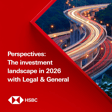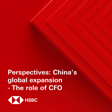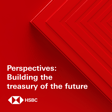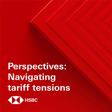Become a Creator today!Start creating today - Share your story with the world!
Start for free
00:00:00
00:00:01

Under the Banyan Tree – Commodities in context
From inflation to political tensions, Paul Bloxham, Chief Economist for Global Commodities, joins Fred to talk through various factors keeping commodity markets deceptively flat at the moment.
Disclaimer: https://www.research.hsbc.com/R/101/S9wjzKP
Stay connected and access free to view reports and videos from HSBC Global Investment Research, just search for #HSBCResearch on LinkedIn or click here: https://www.gbm.hsbc.com/insights/global-research.
Transcript
Introduction to the Podcast
00:00:00
Speaker
This podcast was recorded for publication on Thursday the 2nd of October by HSBC Global Investment Research. Analystifications, disclosures and disclaimers must be viewed on the link attached to your media player.
Focus on Asian and Commodities Markets
00:00:21
Speaker
Welcome to Under the Banyan Tree, where we put Asian markets and economics in context. I'm Fred Newman, chief Asia economist here at HSBC in Hong Kong. On today's show, we're catching up on the commodities market with our chief commodities guru, Paul Bloxham, based in Sydney. Prices across the board are broadly flat, but within that, there are a lot of forces at play.
Commodity Price Trends
00:00:42
Speaker
What are they and how are they impacting the economy globally and here in Asia, from industrials to oil, gold, grains and beyond? Let's get the conversation started under the Benyant Tree.
00:01:09
Speaker
So Paul, welcome to the podcast. You've obviously have followed commodity markets for many, many years now, and you just released also an in-depth report diving deeply into some of the contemporary issues. But before discussing that, I wanted to take a step back because if you look at commodity prices in recent years,
00:01:28
Speaker
they've actually held up quite well if you compare it pre-pandemic levels. And that is despite the fact that the Chinese commodity that's a big consumer of commodities actually has kind of sputtered along.
00:01:40
Speaker
And yet commodity prices are a lot higher. What do you attribute the the fact to that commodity prices have actually held up quite well in recent years? So thanks for having me on. It's it's great to be here. and And you're absolutely right. They look as though they've held up reasonably well in nominal terms relative to where we were prior to the pandemic, as you say.
00:02:00
Speaker
So I think there's a couple of stories at work here. One story is that, you know, although commodity prices, as you say, have held up, actually, we've had this big surge in inflation. So the overall price level ah is higher as well.
00:02:14
Speaker
So if you adjusted these commodity prices and compared them to like the US CPI and overall price metric, actually we don't look like we've held up that well. They look basically like they're in line with their average. So what we're saying is real commodity prices are actually broadly in line with their average. They're not a lot higher.
00:02:31
Speaker
than they were
Industrial vs Precious Metals
00:02:32
Speaker
pre-pandemic. I think then- That's that's actually an an interesting point. I just wanted to emphasize that. So you're saying in real terms, the sticker shock might still be there. and Their sticker is still very high. I mean, it seems high compared to where we were maybe six, seven years ago.
00:02:48
Speaker
But you're saying if we adjusted for inflation, actually commodity prices aren't that high. That would also suggest that maybe they're not really bound to fall much further because they're actually in real terms are relatively cheap at the moment.
00:03:04
Speaker
Certainly, that seems to be the case. And it's also, I think, worth keeping in mind that they have actually been broadly tracking sideways for the past couple of years. So, you know, we're in this world where they have tracked sideways, and they've tracked sideways at about their inflation adjusted or real average level. And so um that's right. And that's also the house view that and they'll continue to track broadly sideways for the next couple of years. And the the thing that I would throw in next though is if you look a little below the surface, you find quite a lot of divergence across the different types of commodities. So and certainly this year,
00:03:42
Speaker
The big feature has been that you've seen a very strong rise in gold prices and silver prices, platinum, palladium, you know a lot of upside to the precious metals. And that's that's sort of a safe haven flow story. that's That's money flowing into those things because there's concern about other asset classes and so on.
00:04:00
Speaker
um But if you looked at industrial commodities, so oil prices, energy prices, metals prices that are the the industrial metals, they've actually been trending lower. So the reason you've ended up with this sort of steady combination of commodity prices tracking sideways has been that the rising gold has approximately offset um the fall in those other industrial commodities. So there's a few more stories out of the surface.
00:04:22
Speaker
That's interesting. and And I wanted to start with industrial commodities, um because they are really an indicator of underlying demand globally. ah and I mean, there's obviously supply dynamics, but really, ah we look, for example, to copper, we look to iron ore as indicators of global economic vitality.
00:04:41
Speaker
What are those particular um commodities tell you at the moment? Well, I think if you if you look at the metals space, those metals prices have actually held up reasonably well. as As we started off the conversation, perhaps it's a little bit surprising how well they've held up, ah given that it does appear that demand has weakened a bit. I think there's a there's a story here about, well, demand has actually held up reasonably well in the manufacturing sector so far.
00:05:04
Speaker
And that a part of that is front-loading of activity ahead of the arrival of tariffs. And that's a story I know you've written quite a bit about. and And I think that story is also playing through in terms of holding up metals prices in some sort of way. I think the other thing for industrial metals is that actually it is a supply story. We have not been investing in very much mining capacity in recent years.
00:05:25
Speaker
And so actually the supply constraint is one of the features that's holding up these metals prices in a way that might be surprising given the sort of weaker global growth story.
Oil Price Dynamics
00:05:35
Speaker
And then on energy, well, oil in particular, oil prices have come down.
00:05:39
Speaker
They've been coming down through the year. And that partly reflects a sort of weakening demand story, but it really primarily reflects that there's been more supply added to the global system. And that's partly the OPEC plus story where they had been holding a lot of oil off the global market to maintain prices at more elevated levels. And they've been adding it back in in the past year or so.
00:06:00
Speaker
And that's added quite a lot of supply and put downward pressure on prices. Now, you've talked about oil here, and I think that's an interesting indicator because, of course, we look to oil prices as providing a signal ah to the global economy. Now, as you rightly say, there's supply and demand dynamics. um We've seen weaker demand come through.
00:06:20
Speaker
Partly, I would imagine that's for cyclical reasons because the global economy, particularly China, isn't growing as rapidly. But how much is there also structural story whereby we already see the displacement of oil because of, say, a switch to electric vehicles? is that too early ah to to say that yet?
00:06:38
Speaker
I think it's still too early to see that as a part of the bigger picture story. I think, yes, the China slowdown story is having some impact on oil demand, and that's that's that's clear.
00:06:49
Speaker
But I think we're still expecting that we haven't yet gotten to peak oil in China. i think you know The most interesting thing in the oil space at the moment is that that there is expected to be excess oil on the global market. That's what the team thinks. They think that actually you're going to end up with excess supply. And the big question at the moment is that excess supply at the moment is getting absorbed by China stockpiling.
00:07:13
Speaker
So they've been ramping up their inventories onshore, rebuilding their strategic reserves and continuing to do that. So they've been acting as a source of demand in stockpiling. And how long that goes on for is the really outstanding question at the moment. And the oil team's grappling with that about whether that if that were to slow down or stall, then that would put further downward pressure on oil prices. So we've got a working assumption that oil prices are $65 a barrel next year, but we've got a downside risk because we think, well, the demand side's weak, the supply side's ample, and we're really reliant on this stockpiling story in China ah to continue to support the price. If I kind of um summarize, and correct me if I'm wrong, if you look at industrial commodities, but also the oil market,
00:07:54
Speaker
You seem to suggest that there are still downside risks. We talked about front-loading, kind of flattering the demand a little bit for industrial commodities. That, of course, could start to break away as we sort to see a payback for the front-loading.
00:08:09
Speaker
um And then you also hint at more supply coming on stream in the oil market. And unless we get a big underlying demand resurgence because China cannot stockpile oil forever, is it fair to say that there's a risk here of demand weakening in the coming quarters and therefore prices declining?
00:08:26
Speaker
That's right. I mean, that's the assessment. we we We come to the view that although our central case is commodity prices track broadly sideways, um that there is downside risk to that. And that's partly due to and expectation that global growth is going to slow. and i that's partly the front-loading story rolling off, as you've described.
00:08:45
Speaker
But it's also supply-side story where, particularly for energy, we've got an ample supply of energy. I mean, there is more oil coming back into the system from OPEC. As I say, the team is expecting that there's going to be a surplus in the oil market.
00:08:58
Speaker
And then on the gas front as well, I think you know the supply-side story on the energy front in particular gives you more downside. And the demand-side story from the global growth story also gives you some downside. So yes, downside risk to commodity price forecast.
Global Demand and Supply
00:09:12
Speaker
So you you broadly paint a picture of maybe ah mildly disinflationary trends in global commodity markets, which is obviously positive for consuming ah economies and helps the broader disinflation process. and And maybe that's a good time to take a quick break, because when we come back, I want to ask you how geopolitics, a trade war, geoeconomics fits into this and and how that maybe makes the job harder of predicting where commodity prices are going.
Geopolitical Impact on Commodities
00:09:50
Speaker
Well, welcome back. Before the break, we we kind of talked broadly about commodity market trends and and whether you look at industrial commodities, oil markets, or agriculture, there are still mildly disinflationary trends building up, particularly if you assume that the global economy ah continues to cool in the coming quarters. But, Paul, I wanted to ask you really about a political angle here because we've seen, obviously, tariff tensions build up. We've seen geopolitical tensions build up. We see ah this rise of geoeconomics, which is really sort of subsuming economic policy to geopolitical imperatives by many countries.
00:10:27
Speaker
What does all these did geopolitical developments mean for how you think about commodity markets? Well, this is certainly something we've observed that this is playing a an even bigger role in in recent times with the Russia-Ukraine war and then of course all the developments with trade policy coming out of the US and what that means.
00:10:45
Speaker
And you really can see it in commodity markets. So one of the things we we worked through in this report is to you know observe that commodity markets have become more volatile the cycles in commodity markets appear to have become a bit shorter in recent times if you compare them now to what they were like just a few years ago.
00:11:01
Speaker
And you're also seeing increased fragmentation. And what I mean by that is ah you think of the law of one price where you know you think that a commodity or any particular thing might have one price across the world. Well, that's not necessarily the case. You sometimes get markets where you know the price of copper, for example, is higher in the US and lower in other parts of the market. the fragmentation of markets has increased a lot. And we've seen that really observed just over the past year in things like copper, for example, where the price in one market is different to a price in another market. So yes, this concept of sort of geopolitics having a bigger effect on the economy and foreign policy having an impact, sanctions and the like having a big impact on the way commodity markets work is is leading to this. Now, as you alluded to, this is making it much more difficult to pick out
00:11:49
Speaker
sort of trends in commodity markets. It means you're doing a lot of reporting of the things that are going on as they happen, but it's difficult to pick the direction of trends because this is driving things more so maybe than has done in the past. Yeah, let me follow up on this. So you're saying it's It's harder to predict the trends. That's obviously intuitive, quite understandable. We all see fragmentation of markets.
00:12:10
Speaker
um We used to talk about broad commodity cycles when global markets were integrated. They followed, obviously, global demand trends in some long cycles. Is that still the case or does a fragmentation, a political angle kind of disturb the broad cycle? Does it make harder to kind of predict prices six to nine months out, maybe compared to a decade ago?
00:12:33
Speaker
I think it makes it much harder. And one way we did this in in the report is the team that ah that we work with, the the data science team at HSBC, puts together this sophisticated um machine learning statistical tool where they track lots of commodity prices and they look for the trends in each of the individual, just the prices, no no other inputs, just the prices.
00:12:54
Speaker
And this model that they've been running now for a few years is typically used to try and pick whether we're in an upswing or a downswing or whether we're in a super cycle and so on, but it's really struggling at the moment. You know, it was doing a better job in years gone by of sort of being able to pick out these cycles, but just a pure statistical look at the numbers, it's finding it very difficult to confidently pick where we are. And what's interesting is that that really started to break down around 2022, around about when the Russia-Ukraine war started.
00:13:25
Speaker
And actually, it's really broken down a lot more since the the second Trump administration has arrived, when we've gotten these very big shifts, you know, quite volatile shifts in in trade policy coming
Market Unpredictability and Economic Growth
00:13:36
Speaker
out of the US. So yes, it is getting harder, I think, to be able to pick out those trends. And we can say that not just with a casual observation, but we can look at a thorough statistical model that kind of tells us that's the case. That's interesting. So we have evidence that the cycle is becoming harder to predict. um That's partly a result presumably because the fragmentation of markets, the rise of geopolitics.
00:13:58
Speaker
But why would that matter for the average company, for for average growth, if you have more unpredictable commodity prices? I would imagine in part it makes it harder to plan and it raises costs in terms of hedging.
00:14:11
Speaker
ah It raises uncertainty and certainty is always bad for investment. Is it fair to say that this is kind of part of the headwinds for the global economy? yet another example where uncertainty just becomes a headwind to economic growth.
00:14:25
Speaker
I think that's absolutely right. I think, i you know, this is one of the ways i look at this is that shifting policy rapidly, substantially in a way that's unpredictable creates uncertainty. Uncertainty is not good for growth because, as you say, it's very difficult for businesses to make long term decisions about investment and hiring and how they're going to manage their inventories and their systems and so on.
00:14:46
Speaker
I guess what the commodity space, you there's a direct implication, which is you're seeing it in the commodity markets, which is obviously a big input into production for lots of firms. And so that makes it more complicated and they potentially have to do more hedging and so on, as you describe.
00:15:00
Speaker
But I think also in some ways, the commodity markets themselves are giving us an example of where it's evident, where you can see this uncertainty having a bigger effect on different prices and fragmenting markets. And so it's a useful way of sort of tracking and illustrating that we can see the impact of this uncertainty in markets and in key inputs into production. um Paul, this is very in a very illuminating discussion, but I'm just reminded ah you put two economists in a room to the discussed trends and we're left with two conclusions here. One good, one bad. One, the good conclusion is cheaper commodity prices, mild deflation should be a tailwind for consumers of commodities going forward. That's positive. But the negative is that commodity prices have become more unpredictable in that uncertainty in itself.
00:15:47
Speaker
then is a drag on growth rather than something positive. So thank you for all these thoughts, Paul. And I'm sure we're going to check back in with you because, as you rightly say, in your and the big report you recently released clearly shows, commodity price volatility is here to stay. And that's partly reflection of the broader geopolitical uncertainties that we've seen. So thanks for joining us, Paul, here in The Bunion Tree. And talk to you again and soon. Thanks a lot.
00:16:12
Speaker
And that's all we've got time for today, folks. Great having you with us as always. Under the Banyan Tree is an HSBC Global Investment Research production, as is our sister podcast, The Macro Brief. You can listen, like and subscribe to both wherever you get your podcasts.
00:16:27
Speaker
Thanks as always for listening and we'll be back again next week.










